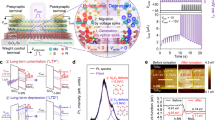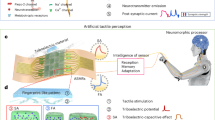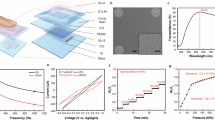Abstract
Tactile visual synapses combine the functionality of tactile artificial synapses with the ability to visualize their activity in real time and provide a direct and intuitive visualization of the activity, offering an efficient route for in situ health monitoring. Herein we present a tactile visual synapse that enables in situ monitoring of finger rehabilitation and electrocardiogram analysis. Repetitive finger flexion and various arrhythmias are monitored and visually guided using the developed tactile visual synapse combined with an electrical and optical output feedback algorithm. The tactile visual synapse has the structure of an electrochemical transistor comprising an elastomeric top gate as a tactile receptor and an electrochemiluminescent ion gel as a light-emitting layer stacked on a polymeric semiconductor layer, forming an electrical synaptic channel between source and drain electrodes. The low-power (~34 μW) visualization of the tactile synaptic activity associated with the repetitive motions of fingers and heartbeats enables the development of a convenient and efficient personalized healthcare system.
This is a preview of subscription content, access via your institution
Access options
Access Nature and 54 other Nature Portfolio journals
Get Nature+, our best-value online-access subscription
$32.99 / 30 days
cancel any time
Subscribe to this journal
Receive 12 print issues and online access
$259.00 per year
only $21.58 per issue
Buy this article
- Purchase on SpringerLink
- Instant access to full article PDF
Prices may be subject to local taxes which are calculated during checkout





Similar content being viewed by others
Data availability
The data that support the findings of this study or additional data related to this study are available from the corresponding author upon reasonable request. Source data are provided with this paper.
References
Chen, Y. et al. Synaptic plasticity powering long-afterglow organic light-emitting transistors. Adv. Mater. 33, 210369 (2021).
Zhu, Y. et al. Intelligent, biomimetic, colour-tunable, light-emitting artificial skin with memory function. Nano Energy 90, 106569 (2021).
Zhao, S. et al. Electroluminescent synaptic devices with logic functions. Nano Energy 54, 383–389 (2018).
Seung, H. et al. Integration of synaptic phototransistors and quantum dot light-emitting diodes for visualization and recognition of UV patterns. Sci. Adv. 8, eabq3101 (2022).
Zhu, Y. et al. Light-emitting memristors for optoelectronic artificial efferent nerve. Nano Lett. 21, 6087–6094 (2021).
Cai, M. et al. A multifunctional electronic skin based on patterned metal films for tactile sensing with a broad linear response range. Sci. Adv. 7, eabl8313 (2021).
Zhang, L. et al. Wearable circuits sintered at room temperature directly on the skin surface for health monitoring. ACS Appl. Mater. Interfaces 12, 45504–45515 (2020).
Luigi, D. et al. Visual, tactile, and contact force feedback: which one is more important for catheter ablation? Results from an in vitro experimental study. Heart Rhythm 11, 506–513 (2014).
Dobiasch, M., Krenn, B., Lamberts, R. P. & Baca, A. The effects of visual feedback on performance in heart rate- and power-based-tasks during a constant load cycling test. J. Sports Sci. Med. 21, 49–57 (2022).
Elor, A. & Kurniawan, S. The ultimate display for physical rehabilitation: a bridging review on immersive virtual reality. Front. Virtual Real. 1, 585993 (2020).
Viirre, E. & Sitarz, R. Vestibular rehabilitation using visual displays: preliminary study. Laryngoscope 112, 500–503 (2002).
Lee, K. et al. Artificially intelligent tactile ferroelectric skin. Adv. Sci. 7, 2001662 (2020).
Wan, C. et al. An artificial sensory neuron with tactile perceptual learning. Adv. Mater. 30, 1801291 (2018).
Kim, Y. et al. A bioinspired flexible organic artificial afferent nerve. Science 360, 998–1003 (2018).
Shim, H. et al. Stretchable elastic synaptic transistors for neurologically integrated soft engineering systems. Sci. Adv. 5, eaax4961 (2019).
Lee, Y. R., Trung, T. Q., Hwang, B. U. & Lee, N. E. A flexible artificial intrinsic-synaptic tactile sensory organ. Nat. Commun. 11, 2753 (2020).
Park, H. L. et al. Retina-inspired carbon nitride-based photonic synapses for selective detection of UV light. Adv. Mater. 32, 1906899 (2020).
Mennel, L. et al. Ultrafast machine vision with 2D material neural network image sensors. Nature 579, 62–66 (2020).
Chen, J. Y. et al. Ultrafast responsive and low-energy-consumption poly(3-hexylthiophene)/perovskite quantum dots composite film-based photonic synapse. Adv. Funct. Mater. 31, 2105911 (2021).
Cheng, Z., Ríos, C., Pernice, W. H. P., David Wright, C. & Bhaskaran, H. On-chip photonic synapse. Sci. Adv. 3, e1700160 (2017).
Lee, K. et al. Retina-inspired structurally tunable synaptic perovskite nanocones. Adv. Funct. Mater. 31, 2105596 (2021).
Wang, Y. et al. Stretchable temperature-responsive multimodal neuromorphic electronic skin with spontaneous synaptic plasticity recovery. ACS Nano. 16, 8283–8293 (2022).
Sun, L. et al. Synaptic computation enabled by Joule heating of single-layered semiconductors for sound localization. Nano Lett. 18, 3229–3234 (2018).
Guo, L. Q., Wen, J., Zhu, L. Q., Fu, Y. M. & Xiao, H. Humidity-dependent synaptic plasticity for proton gated oxide synaptic transistor. IEEE Electron Device Lett. 38, 1248–1251 (2017).
Nie, S., He, Y., Liu, R., Shi, Y. & Wan, Q. Low-voltage oxide-based synaptic transistors for spiking humidity detection. IEEE Electron Device Lett. 40, 459–462 (2019).
Kim, Y. et al. Bird-inspired self-navigating artificial synaptic compass. ACS Nano 15, 20116–20126 (2021).
Kim, H. Y. et al. Shape-deformable and locomotive MXene (Ti3C2Tx)-encapsulated magnetic liquid metal for 3D-motion-adaptive synapses. Adv. Funct. Mater. 33, 2210385 (2022).
Yu, J. et al. Contact-electrification-activated artificial afferents at femtojoule energy. Nat. Commun. 12, 1581 (2021).
Shan, L. et al. A sensory memory processing system with multi-wavelength synaptic-polychromatic light emission for multi-modal information recognition. Nat. Commun. 14, 2648 (2023).
Chen, Y. et al. Nanofloating gate modulated synaptic organic light-emitting transistors for reconfigurable displays. Sci. Adv. 8, eabq4824 (2022).
Chen, Q. et al. Neuromorphic display system for intelligent display. Nano Energy 94, 106931 (2022).
Deheyn, D. D. & Wilson, N. G. Bioluminescent signals spatially amplified by wavelength-specific diffusion through the shell of a marine snail. Proc. R. Soc. B 278, 2112–2121 (2011).
Ohmiya, Y., Kojima, S., Nakamura, M. & Niwa, H. Bioluminescence in the limpet-like snail, Latia neritoides. Bull. Chem. Soc. Jpn. 78, 1197–1205 (2005).
Lee, K. H. et al. ‘Cut and stick’ rubbery ion gels as high capacitance gate dielectrics. Adv. Mater. 24, 4457–4462 (2012).
Choi, Y., Oh, S., Qian, C., Park, J. H. & Cho, J. H. Vertical organic synapse expandable to 3D crossbar array. Nat. Commun. 11, 4595 (2020).
Lee, S., Lee, H. J., Ji, Y., Lee, K. H. & Hong, K. Electrochemiluminescent transistors: a new strategy toward light-emitting switching devices. Adv. Mater. 33, 2005456 (2021).
Guo, W. et al. Potential-resolved multicolor electrochemiluminescence for multiplex immunoassay in a single sample. J. Am. Chem. Soc. 140, 15904–15915 (2018).
Adamson, N. S. et al. Emission from the working and counter electrodes under co-reactant electrochemiluminescence conditions. Chem. Sci. 12, 9770–9777 (2021).
Rivnay, J. et al. High-performance transistors for bioelectronics through tuning of channel thickness. Sci. Adv. 1, e1400251 (2015).
Furukawa, Y. & Shimokawa, D. Polarons, bipolarons, and electrical properties of crystalline conducting polymers. Bull. Chem. Soc. Jpn. 96, 1243–1251 (2023).
Kachuee M., Fazeli S. & Sarrafzadeh M. ECG heartbeat classification: a deep transferable representation. In 2018 IEEE International Conference on Healthcare Informatics (ICHI) 443–444 (IEEE, 2018).
Choi, S., Yang, J. & Wang, G. Emerging memristive artificial synapses and neurons for energy‐efficient neuromorphic computing. Adv. Mater. 32, 2004659 (2020).s
Acknowledgements
This study was supported by the Creative Materials Discovery Program and the Pioneer Research Centre Program through the National Research Foundation of Korea (NRF) funded by the Ministry of Science, ICT & Future Planning (NRF-2022M3C1A3081211), by a grant from the National Research Foundation of Korea (NRF) funded by the Korean government (MEST) (RS-2023-00208577), by the Nano & Material Technology Development Program through the National Research Foundation of Korea (NRF) funded by the Ministry of Science and ICT (RS-2024-00451891 and RS-2024-00416938), and by the Open Resource Research Program of the Korea Institute of Science and Technology (2E32961). This study was also supported by the National R&D Program administered by the National Research Foundation of Korea (NRF) of the Korea government (Grant NO. RS-2024-00407271, RS-2023-00220077 and RS-2024-00342191) and Korea University Research Grant.
Author information
Authors and Affiliations
Contributions
W.K. and K.L. conceived and designed the experiments. S.C. performed and analysed neural network simulations. E.P. performed the spectroelectrochemical measurement on the P3HT film. G.K. performed the fabrication and demonstration of the ECL-TVS and prepared the figures. J. Ha assisted in some of the experiments, including ion gel preparation and electrical characterization. Yeeun Kim, J.J., J.H.O. and H.K. performed ECL spectra, scanning electron microscopy and X-ray photoelectron spectroscopy measurements and prepared brightness extraction algorithm developments. T.K. and Yeonji Kim assisted with the characterization of ECL ion gel properties. K.-N.K., W.J. and J.Y. prepared a brightness extraction algorithm. A.J. advised on the optical measurements and analyses. J. Hong and D.R. devised a rehabilitation treatment protocol and advised on the relevant content. T.-W.L. and K.K. participated in the discussions regarding the experimental results and provided an interpretation of them. G.W. and C.P. supervised the project, analysed the data and wrote the manuscript. All authors discussed the results and commented on the study.
Corresponding authors
Ethics declarations
Competing interests
The authors declare no competing interests.
Peer review
Peer review information
Nature Materials thanks Paschalis Gkoupidenis, Qijun Sun and the other, anonymous, reviewer(s) for their contribution to the peer review of this work.
Additional information
Publisher’s note Springer Nature remains neutral with regard to jurisdictional claims in published maps and institutional affiliations.
Extended data
Extended Data Fig. 1 Full-colour ECS-TVS.
(a) A plot of the PSC response of an R-ECL-TVS, utilising 20 Vgs pulses sequentially increasing in magnitude. The inset photographs display the light emission of R-ECL-TVS at the increasing number of Vgs pulses. scale bar: 5 mm. (b) Photographs of R, G, and B-ECL-TVS with continuous 15 gate voltage pulses, sequentially increasing in magnitude from −2.2 V to −5 V. Scale bar: 3 mm. (c) Plot of the PSC response of integrated R-, G-, and B- ECL-TVS, utilising 15 gate voltage pulses comprising three sets of five voltage pulses with different voltage magnitudes (−2.7 V for five pulses, −3.3 V for five pulses, and −4.5 V for five pulses) under pressure of 17.20 kPa. (d) Photographs of integrated R-, G-, and B- ECL-TVS at the 1st, 5th, 6th, 10th, 11th, and 15th Vgs pulses. Scale bar: 5 mm.
Supplementary information
Supplementary Information
Supplementary Tables 1–4, Notes 1–7 and Figs. 1–45.
Supplementary Video 1
Full-colour ECL-TVS operation.
Supplementary Video 2_1
Index-finger exercise monitoring.
Supplementary Video 2_2
Middle-finger exercise monitoring.
Supplementary Video 2_3
Ring-finger exercise monitoring.
Supplementary Video 3
Battery-driven wearable ECL-TVS operation.
Source data
Source Data Fig. 1
Fig. 1e,f.
Source Data Fig. 2
Fig. 2d–k.
Source Data Fig. 3
Fig. 3a–e,h.
Source Data Fig. 4
Fig. 4c,d.
Source Data Fig. 5
Fig. 5c–f,i.
Source Data Extended Data Fig. 1
Extended Data Fig. 1a,c.
Rights and permissions
Springer Nature or its licensor (e.g. a society or other partner) holds exclusive rights to this article under a publishing agreement with the author(s) or other rightsholder(s); author self-archiving of the accepted manuscript version of this article is solely governed by the terms of such publishing agreement and applicable law.
About this article
Cite this article
Kim, W., Lee, K., Choi, S. et al. Electrochemiluminescent tactile visual synapse enabling in situ health monitoring. Nat. Mater. 24, 925–934 (2025). https://doi.org/10.1038/s41563-025-02124-x
Received:
Accepted:
Published:
Issue date:
DOI: https://doi.org/10.1038/s41563-025-02124-x
This article is cited by
-
Synapse-powered vitality
Nature Materials (2025)
-
Edge intelligence through in-sensor and near-sensor computing for the artificial intelligence of things
npj Unconventional Computing (2025)
-
Recent progress in flexible synaptic transistors: from materials, structures to applications
Science China Materials (2025)



